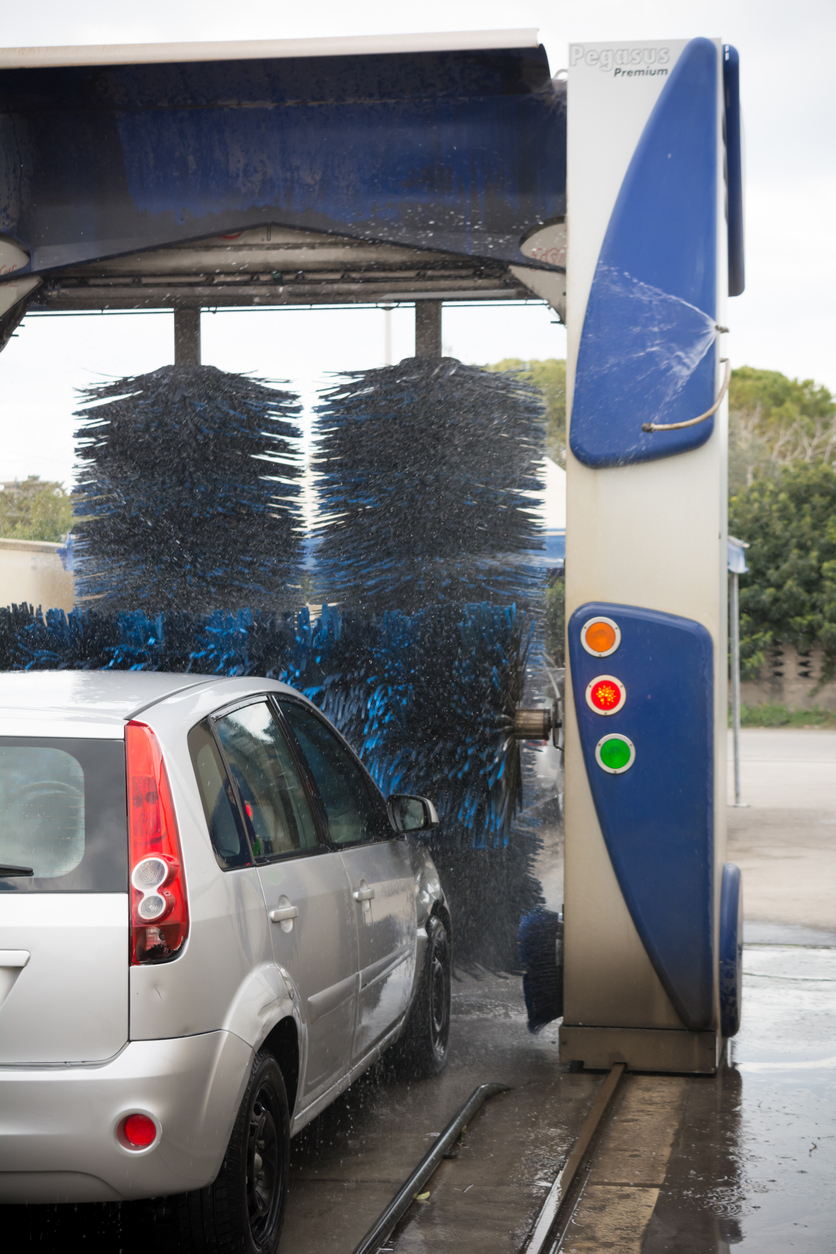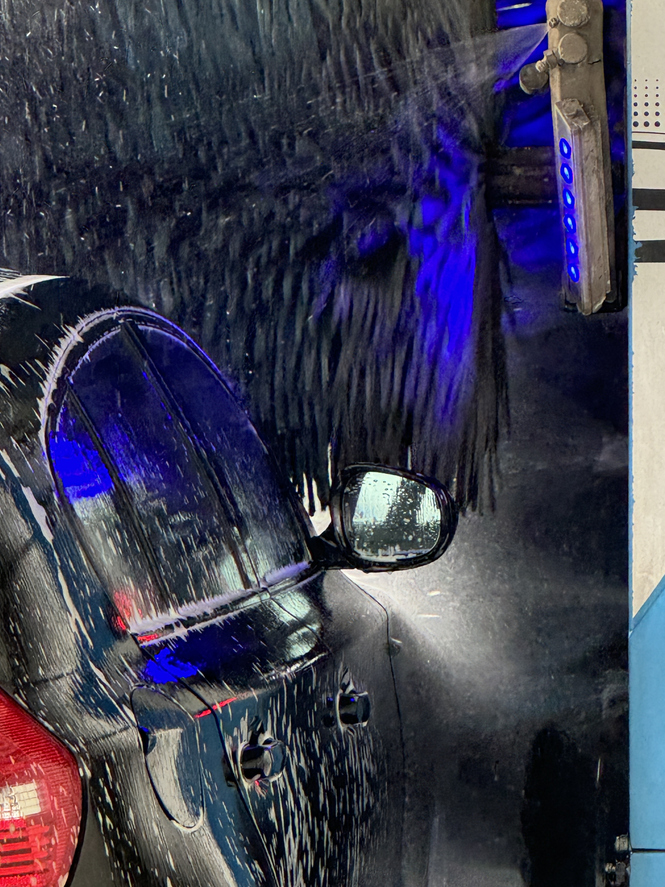
The Future of Automated Carwashes
By Diane M. Calabrese | Published January 2025
 A person with a dirty car is very much in need of someone to wash it. (“It’s a truth universally acknowledged…” in the words of Jane Austen.)
A person with a dirty car is very much in need of someone to wash it. (“It’s a truth universally acknowledged…” in the words of Jane Austen.)
Thus, if there are automobiles, they will require cleaning. The who and how of cleaning depends upon the owner.
The vehicle’s owner may take on the task with a bucket, hose, and chamois cloth. A DIY approach makes it easier to get the desired result, apply a soft touch, and save a bit of money.
Increasingly states and municipal governments are putting restrictions on car washing at home. Drought conditions in many U.S. regions in 2024 put washing at home off limits.
Conserving water is a must at any time. Anyone washing a car at home without an automatic shutoff nozzle should just commit to purchasing the nozzle. There’s no reason to use an average of 100 gallons of water to wash a car when a cut-off nozzle (or a trip to a commercial wash) can reduce that amount by half or more.
The International Carwash Association (ICA) reports that more than 80 percent of car owners most often turn to a commercial wash to get their car cleaned. Self-serve, in-bay, and conveyor are among the configurations a car may meet when its owner decides that there’s a better choice than do-it-yourself.
In fact, the better choice applies in many ways—not just time saving for the owner. Efficient use of water—including recycling—is one gain. Minimizing use of energy is another.
Most commercial washes fall into the automated category. But there are some that do high-end cleaning (and detailing) with the tender loving-care touch of employees who take on manual cleaning.
Automated car washes have grown more and more sophisticated. Touchless washes substitute a combination of water jets and chemicals for any kind of slapping, brushing, or rubbing with mechanical rollers.
Are automated car washes the future for all cleaning? Let’s get some perspective from Keith Bailey, the automation equipment sales manager for Hydro-Chem Systems (HCS) in Caledonia, MI. Bailey has been with his company for 12 years.
“Yes” to an Automated Future
Challenges in hiring, retention, and cost of labor transcend industries. Working with fewer employees doing more reduces costs. Automation makes much of the fewer-and-more equations possible.
“In an era where labor costs are on the rise and the pool of willing workers diminishes, the vehicle washing industry is experiencing a transformative shift toward automation,” says Bailey. “This evolution not only addresses labor challenges but also enhances efficiency, consistency, and environmental sustainability.”
Look in the rearview mirror when looking at washing without automation. “Gone are the days of manual vehicle washing, which typically takes 45 minutes,” says Bailey.
“Automated washes can now complete the task in just three minutes,” explains Bailey. Not only can more vehicles be cleaned per unit time, but they can be more thoroughly cleaned.
Some parts of a vehicle may not get the attention they require with manual cleaning, says Bailey. Automated systems “thoroughly clean areas often neglected by hand, such as the undercarriage, ensuring comprehensive maintenance that extends the life of the vehicle.”
More than car longevity is in play, though. Aesthetics matter, especially when a vehicle is used by a company, serves as a rental, or conveys passengers via the hands of ride-share drivers.
“For businesses, maintaining a clean fleet is a strategic investment in brand image,” says Bailey. “In today’s competitive market, a well-kept appearance can set a company apart, reinforcing their commitment to quality and professionalism.”
In fact, a clean vehicle showcases attention to detail and more. “With the cost-effectiveness of automated washes, businesses can enhance their public image without breaking the bank,” says Bailey.
Automated systems will keep benefiting from innovation, and that’s a boon to vehicle owners. “As technology continues to advance, the vehicle washing sector is poised for further innovation,” says Bailey.
With a streamlined, automated system, more people are free for other tasks. “Companies can now redirect human resources to more critical tasks requiring personal interaction,” explains Bailey.
Overall, automation accelerates the move toward many goals simultaneously. “It boosts operational efficiency and aligns with broader sustainability goals, reducing water and energy consumption,” says Bailey.
Sustainable practices loom large in all places. Many companies document their strides in their achievement of them.
Bailey reminds us that automated large vehicle washes offer several significant advantages in sustainability. “One of the key benefits of automated washes is their ability to operate within a controlled environment.”
A controlled environment facilitates efforts to contain wastewater. Wastewater can be more easily routed to a collection system for treatment and disposal or recycling.
It’s not just about capturing pollutants before they escape to the environment. “In many cases automated washes employ advanced water reclamation systems, allowing them to significantly reduce overall water consumption during each wash,” says Bailey.
Still, if chemicals are substituting for mechanical agitation during a wash, don’t the chemicals become a concern? They should not if all is planned well.
“The detergents used in high-quality truck washes are formulated to be environmentally friendly,” says Bailey. “When used correctly, they typically have a near-neutral pH at discharge, which minimizes environmental impact.”
The environmental friendliness of chemicals takes many forms. “Today’s leading truck wash detergents are not only biodegradable but also phosphate-free, aligning with modern regulations and eco-friendly practices,” says Bailey.
“By prioritizing sustainable methods, automated vehicle washes are not just cleaning fleets; they’re contributing to a healthier planet,” says Bailey. “As the industry continues to innovate, the integration of environmentally responsible practices will play a critical role in shaping the future of vehicle maintenance.”
Broad View of Automation
Every type of car wash benefits from automation. It’s because automation makes it possible to do more with less.
Hands-off and mechanical-devices-off automated (aka frictionless) washes that use jets and detergents represent the top tier. But a commitment to best practices means all types of car washes have moved toward the same result.
The same sort of best practices that conserve water and energy in all settings apply to car washes. If there’s a conveyor, it must be maintained. So, too, must the nozzles, which require periodic checks on orientation.
Just as sensors to sound the alarm about problems are built into vehicles, they can be built into any kind of automated car wash. Designing for a buildout that incorporates ways to save water and energy allows for continuous improvement.
The term “automated” has been applied to car washes for at least 60 years. Now the term means much more than a type of mechanization. Often, it means touchless. And increasingly it’s likely to include an AI component that directs the automated system to provide more attention to the parts of a vehicle that require a bit extra.
Similarly, AI coupled with automation can make it easier to sort through the type of water treatment (including reclamation) that should be deployed. Water volume, chemical concentration, and limits on discharge set by a municipality are just three of the many variables that must be assessed to successfully treat wastewater (and choose a method for treatment).
How often should a vehicle be washed? What’s the ideal interval for keeping the vehicle clean, reducing the amount of water (and chemicals) used, and preserving the finish?
Ultimately, we can expect sensors built into vehicles to indicate when it’s time to clean a vehicle. And we can probably also anticipate the information will be conveyed to an automated wash that will then respond to a specific vehicle with the exact sort of cleaning it requires.





